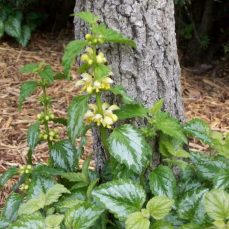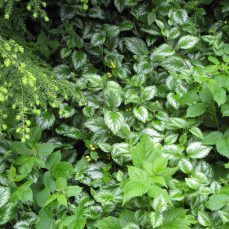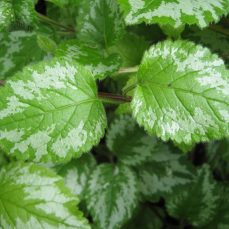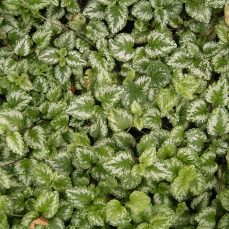
Management Strategy
Squamish
Whistler
Pemberton
Vectors of Spread
Synonyms
Yellow archangel, yellow deadnettle, and yellow weaselsnout.
ID Characteristics
General: Yellow lamium is an evergreen, perennial groundcover that can grow trailing or upright over low-growing vegetation.
Leaves: Variegated green and silver oval leaves with tapered edges. Yellow lamium leaves can have a grey outer margin.
Flowers: Small and yellow with orange or brown markings on them. Flowers have hooded upper petals and a lipped lower petal. Together, they form into four nutlets, each containing one seed.
Fruit: Each flower produces four small nuts (nutlets), with each nutlet containing one seed.
Stems: Erect, four-sided (square) stems can grow 30 – 60 cm tall.
Roots: Yellow lamium has a shallow root system. It also produces above-ground horizontal runners (called stolons) that root and grow new plants.
Similar Species
Invasive

Goutweed, Bishop’s weed, or ground elder (Aegopodium podagraria) can be differentiated from yellow lamium by its leaves that grow in groups of 3. It also has white flowers arranged in umbels or umbrella-shaped clusters.
Habitat and Origin
From Europe, Asia, and North Africa. Yellow lamium was originally brought to North America as a garden ornamental.
Yellow lamium grows in a wide range of conditions, but it does best in full shade forests with moist soils that are rich in organic matter. It is found in ravines, greenbelts, and forested parks. Yellow lamium is often purchased as a garden ornamental, so it is also found in hanging planter baskets, in gardens as well as growing along ornamental borders.
How it Spreads
Yellow lamium reproduces vegetatively (from stolons and from stem fragments). It can also reproduce from seed, but it is less common.
Yellow lamium is sometimes sold as an ornamental in garden stores. It spreads by stolons (horizontal runners), crawling under fences into woodland margins, parks, ditches, and other natural spaces. Stem fragments can form an entirely new plant.
Seeds are a secondary form of dispersal that can be spread by wind, water, plants and animals. Ants have also been reported to have transported seeds up to 70 m away from the parent plant.
Impacts
Ecological:
- Less valuable than other plants to livestock and wildlife
- Outcompetes native species by blocking access to sunlight and restricting space availability with its extensive root system
- Reduces food availability for wildlife; impacts local pollinators
Economic:
- Can displace shade-tolerant crops and reduce yields
Stop the Spread
Yellow lamium is abundant in certain portions of the Sea to Sky region, but has not yet infested all potential habitats. The goal is to contain the spread of yellow lamium.
Learn to identify yellow lamium: use the images presented in this profile page to learn how to identify yellow lamium.
What to do if you spot it: You can report any Yellow Lamium sighting by visiting our reporting page.
DO:
- Regularly monitor properties for weed infestations.
- Ensure soil and gravel are uncontaminated before transport.
- Check wildflower mixes to ensure that they do not contain yellow lamium.
- Ensure that all plant parts, including floral arrangements, are bagged and disposed of properly in the household stream. Do not compost, as any seeds present are likely to survive the composting process.
- Ensure that all stem and root fragments are removed when controlling yellow lamium, as these fragments can sprout into new plants.
DO NOT:
- Purchase yellow lamium from a garden centre or nursery.
- Cut or mow yellow lamium, as new plants can sprout from root or stem fragments.
- Unload, park or store equipment or vehicles in infested areas; remove plant material from any equipment, vehicles or clothing used in such areas and wash equipment and vehicles at designated cleaning sites before leaving infested areas.
- Plant yellow lamium in a garden, no matter how well-contained its enclosure may seem.
- Move soil, fill, or gravel that has been contaminated with yellow lamium.
Control
Mechanical
- Since yellow lamium has relatively shallow roots, hand-pulling tends to be a relatively effective method. However, care should be taken to remove as many plant fragments as possible, as any root and stem fragments could sprout into new plants.
- Aim to remove as much of the root system as possible, which may be easiest to do in the early spring when the soil is moist.
- Sites should be monitored every year for re-growth after any mechanical removal.
Chemical
- Glyphosate, triclopyr, or imazapyr have been recorded as effective herbicides for this species. Tank mixtures of glyphosate and either triclopyr or imazapyr has been shown to be more effective than single-product applications.
- An addition of a surfactant to either triclopyr or glyphosate appears to also be effective.
- Applications should occur during the fall and spring when yellow lamium is most active, but before the blooming period in the spring to reduce any impacts on pollinators.
- Multiple treatments may be required and monitoring following a chemical treatment is recommended.
- We recommend that any herbicide application is carried out by a person holding a valid BC Pesticide Applicator Certificate. Before selecting and applying herbicides, you must review and follow herbicide labels and application rates; municipal, regional, provincial and federal laws and regulations; species-specific treatment recommendations, and site-specific goals and objectives.
Biological
- There is no biocontrol available for yellow lamium at this time.
Sea to Sky Distribution
Yellow Lamium Factsheet
Having trouble viewing the factsheet? Don’t worry, all the information is included on this page. You can also contact us with any questions.
Additional Resources
References
- Japanese Knotweed Ltd, How to remove Variegated yellow archangel.
- Fraser Valley Invasive Species Council, Yellow Lamium.
- iNaturalist, Variegated Yellow Archangel.
- Invasive Council of Metrovancouver, Yellow Lamium.
- Invasive Plant Atlas, Yellow Lamium.
- Invasive Species Council of BC, Yellow Lamium Factsheet.
- Invasive Species Council of BC, Yellow Lamium.
- King County, Yellow Archangel.
- Metrovancouver, Yellow Archangel Best Management Practices.
- Metrovancouver, Yellow archangel Factsheet.
- Minnesota Wildflowers, Yellow Archangel.
- Salt Spring Conservancy, Yellow Lamium.
- Washington State Noxious Weed Control Board, Yellow Lamium.















